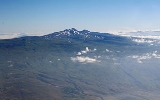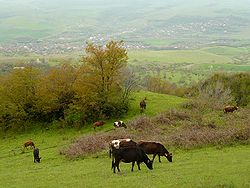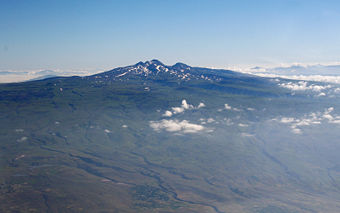
Agriculture in Armenia
Encyclopedia



Armenia
Armenia , officially the Republic of Armenia , is a landlocked mountainous country in the Caucasus region of Eurasia...
has 2.1 million hectares of agricultural land
Agricultural land
Agricultural land denotes the land suitable for agricultural production, both crops and livestock. It is one of the main resources in agriculture...
, 72% of the country's land area. Most of this, however, is mountain pastures, and cultivable land is 480,000 hectares (452,900 hectares arable land
Arable land
In geography and agriculture, arable land is land that can be used for growing crops. It includes all land under temporary crops , temporary meadows for mowing or pasture, land under market and kitchen gardens and land temporarily fallow...
, 27,300 hectares in orchards and vineyards), or 16% of the country's area. In 2006, 46% of the work force was employed in agriculture (up from 26% in 1991), and agriculture contributed 21% of the country's GDP. In 1991 Armenia imported about 65 percent of its food.
Land privatization
In 1990 Armenia became the first Soviet republicRepublics of the Soviet Union
The Republics of the Soviet Union or the Union Republics of the Soviet Union were ethnically-based administrative units that were subordinated directly to the Government of the Soviet Union...
to pass a land privatization
Privatization
Privatization is the incidence or process of transferring ownership of a business, enterprise, agency or public service from the public sector to the private sector or to private non-profit organizations...
law, and from that time Armenian farmland shifted into the private sector at a faster rate than in any other republic. However, the rapidity and disorganization of land reallocation led to disputes and dissatisfaction among the peasants receiving land. Especially problematic were allocation of water rights and distribution of basic materials and equipment. Related enterprises such as food processing and hothouse operations often remained in state hands, reducing the advantages of private landholding.
Swift and decisive privatization quickly eliminated the collective and state farms
Kolkhoz
A kolkhoz , plural kolkhozy, was a form of collective farming in the Soviet Union that existed along with state farms . The word is a contraction of коллекти́вное хозя́йство, or "collective farm", while sovkhoz is a contraction of советское хозяйство...
, which had dominated Armenian agriculture in the Soviet period. Already by 1992 privatization of the state and collective farms had put 63% of cultivated fields, 80% of orchards, and 91% of vineyards in the hands of family farmers. In 2006, family farmers were producing 98% of gross agricultural output, i.e., in 15 years Armenian agriculture transformed completely from the traditional Soviet model of large agricultural enterprises to the market-oriented model of individual or family farms.
The privatization program yielded an immediate 15% increase in gross agricultural output between 1990 and 1991. Agricultural growth continued unabated, and by 2006 gross agricultural output had increased by 75% compared with its level in 1990. This growth record has not been matched by any of the CIS
CIS
CIS usually refers to the Commonwealth of Independent States, a modern political entity consisting of eleven former Soviet Union republics.The acronym CIS may also refer to:-Organizations:...
countries, putting Armenia in a unique position of stellar agricultural performer in CIS. In 1993 the government ended restrictions on the transfer of private land, a step expected to increase substantially the average size (and hence the efficiency) of private plots. At the end of 1993, an estimated 300,000 small farms (one to five hectares) were operating. In that year, harvests were bountiful despite the high cost of input; only the disastrous state of Armenia's transportation infrastructure prevented relief of food shortages in urban centers.
Agricultural production
Agriculture is carried out mainly in the valleys and mountainsides of Armenia's uneven terrain, with the highest mountain pastures used for livestock grazing. Fertile volcanic soil allows cultivation of wheatWheat
Wheat is a cereal grain, originally from the Levant region of the Near East, but now cultivated worldwide. In 2007 world production of wheat was 607 million tons, making it the third most-produced cereal after maize and rice...
and barley
Barley
Barley is a major cereal grain, a member of the grass family. It serves as a major animal fodder, as a base malt for beer and certain distilled beverages, and as a component of various health foods...
as well as pasturage for sheep, goat
Goat
The domestic goat is a subspecies of goat domesticated from the wild goat of southwest Asia and Eastern Europe. The goat is a member of the Bovidae family and is closely related to the sheep as both are in the goat-antelope subfamily Caprinae. There are over three hundred distinct breeds of...
s, and horse
Horse
The horse is one of two extant subspecies of Equus ferus, or the wild horse. It is a single-hooved mammal belonging to the taxonomic family Equidae. The horse has evolved over the past 45 to 55 million years from a small multi-toed creature into the large, single-toed animal of today...
s. With the help of irrigation
Irrigation
Irrigation may be defined as the science of artificial application of water to the land or soil. It is used to assist in the growing of agricultural crops, maintenance of landscapes, and revegetation of disturbed soils in dry areas and during periods of inadequate rainfall...
, fig
Ficus
Ficus is a genus of about 850 species of woody trees, shrubs, vines, epiphytes, and hemiepiphyte in the family Moraceae. Collectively known as fig trees or figs, they are native throughout the tropics with a few species extending into the semi-warm temperate zone. The Common Fig Ficus is a genus of...
s, pomegranate
Pomegranate
The pomegranate , Punica granatum, is a fruit-bearing deciduous shrub or small tree growing between five and eight meters tall.Native to the area of modern day Iran, the pomegranate has been cultivated in the Caucasus since ancient times. From there it spread to Asian areas such as the Caucasus as...
s, apricots, and olives also are grown in the limited subtropical Aras River valley and in the valleys north of Yerevan, where the richest farmland is found. Armenia also produces peach
Peach
The peach tree is a deciduous tree growing to tall and 6 in. in diameter, belonging to the subfamily Prunoideae of the family Rosaceae. It bears an edible juicy fruit called a peach...
es, walnut
Walnut
Juglans is a plant genus of the family Juglandaceae, the seeds of which are known as walnuts. They are deciduous trees, 10–40 meters tall , with pinnate leaves 200–900 millimetres long , with 5–25 leaflets; the shoots have chambered pith, a character shared with the wingnuts , but not the hickories...
s, and quince
Quince
The quince , or Cydonia oblonga, is the sole member of the genus Cydonia and native to warm-temperate southwest Asia in the Caucasus region...
, and its cognac enjoys a worldwide reputation.
Irrigation is required by most crops, and the building of canals and a system of irrigation was among the first major state projects of the Soviet republic in the 1920s. By the 1960s, arable land had been extended by 20 percent, compared with pre-Soviet times. Most farms had electricity by the early 1960s, and machinery was commonplace. In the Soviet era, women made up most of the agricultural work force; a large percentage of the younger men had responded to the Soviet industrialization campaign by migrating to urban centers. In 1989 farms were operating about 13,400 tractors and 1,900 combines
Combine harvester
The combine harvester, or simply combine, is a machine that harvests grain crops. The name derives from the fact that it combines three separate operations, reaping, threshing, and winnowing, into a single process. Among the crops harvested with a combine are wheat, oats, rye, barley, corn ,...
. Unlike other CIS
CIS
CIS usually refers to the Commonwealth of Independent States, a modern political entity consisting of eleven former Soviet Union republics.The acronym CIS may also refer to:-Organizations:...
countries, Armenia did not suffer a catastrophic decline in its farm machinery inventory during the privatization, and in 2006 there were 14,600 tractors and 1,700 combines
Combine harvester
The combine harvester, or simply combine, is a machine that harvests grain crops. The name derives from the fact that it combines three separate operations, reaping, threshing, and winnowing, into a single process. Among the crops harvested with a combine are wheat, oats, rye, barley, corn ,...
in Armenian farms.
Agricultural production is heavily biased toward crops, which in 2006 accounted for 64% of gross agricultural output. The principal agricultural products are grain
GRAIN
GRAIN is a small international non-profit organisation that works to support small farmers and social movements in their struggles for community-controlled and biodiversity-based food systems. Our support takes the form of independent research and analysis, networking at local, regional and...
s (mostly wheat and barley), potato
Potato
The potato is a starchy, tuberous crop from the perennial Solanum tuberosum of the Solanaceae family . The word potato may refer to the plant itself as well as the edible tuber. In the region of the Andes, there are some other closely related cultivated potato species...
es, vegetable
Vegetable
The noun vegetable usually means an edible plant or part of a plant other than a sweet fruit or seed. This typically means the leaf, stem, or root of a plant....
s, grape
Grape
A grape is a non-climacteric fruit, specifically a berry, that grows on the perennial and deciduous woody vines of the genus Vitis. Grapes can be eaten raw or they can be used for making jam, juice, jelly, vinegar, wine, grape seed extracts, raisins, molasses and grape seed oil. Grapes are also...
s (both table and wine), and fruit
Fruit
In broad terms, a fruit is a structure of a plant that contains its seeds.The term has different meanings dependent on context. In non-technical usage, such as food preparation, fruit normally means the fleshy seed-associated structures of certain plants that are sweet and edible in the raw state,...
s. In 2006, Armenia produced 212,500 tons of grain, 539,500 tons of potatoes, 915,000 tons of vegetables and melons, 286,000 tons of fruits, and 201,400 tons of grapes. All these numbers (except for grain) constitute significant increases compared with 1989, when Armenia produced 200,000 tons of grain, 266,000 tons of potatoes, 485,000 tons of vegetables, 170,000 tons of fruit, and 119,000 tons of grapes. Livestock production in 2006 reached 66,800 tons of meat (slaughter weight), 620,000 tons of milk, and 464 million eggs. The corresponding livestock production numbers in 1989 were 105,000 tons of meat, 491,000 tons of milk, and 561,000 tons of eggs, i.e., only milk production increased significantly during the post-Soviet period.

